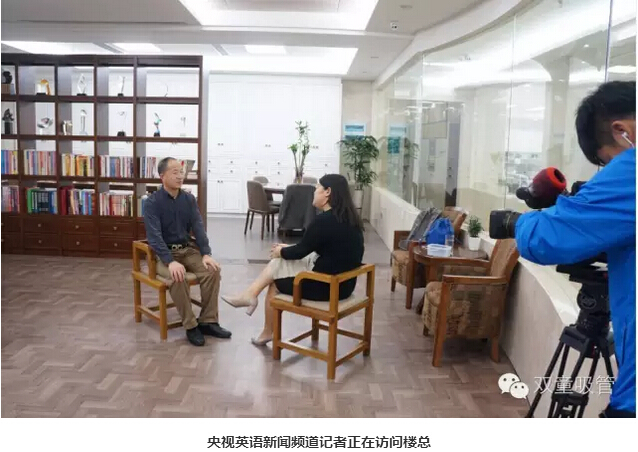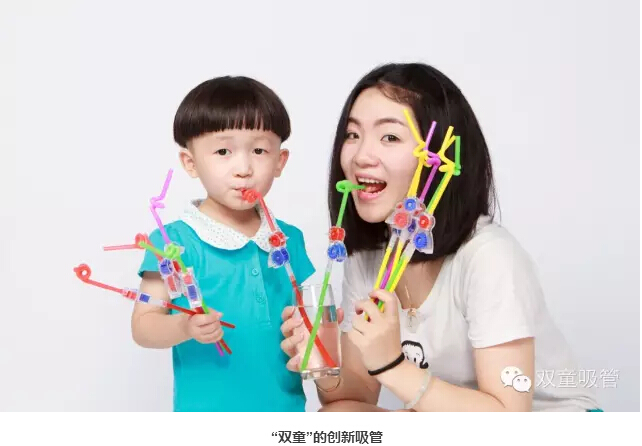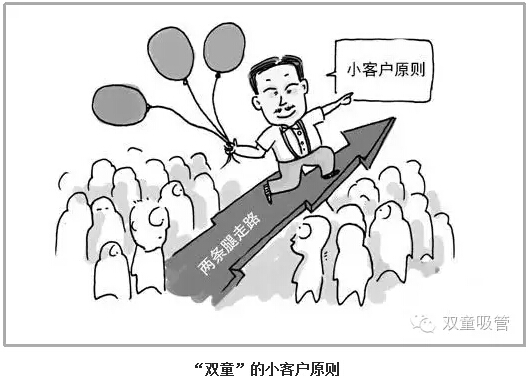
吸管妞導(dǎo)讀
近年來(lái),“雙童”引發(fā)媒體持續(xù)不斷關(guān)注,中央電視臺(tái)更是三番五次到“雙童”錄制節(jié)目!近日,中央電視臺(tái)英語(yǔ)新聞?lì)l道的節(jié)目組也來(lái)到“雙童”采訪(fǎng)當(dāng)家人樓總,據(jù)說(shuō)他們可是準(zhǔn)備將這篇新聞報(bào)道作為中國(guó)中小企業(yè)的典型案例在APEC峰會(huì)上播放呢!下面,妞就帶大家來(lái)看看新聞報(bào)道吧!

中國(guó)中小企業(yè)走向國(guó)際化
央視英語(yǔ)新聞?lì)l道 記者:胡楠
翻譯稿:
我們通常認(rèn)為自由貿(mào)易是大型跨國(guó)公司的專(zhuān)屬領(lǐng)域,但中小型企業(yè)往往有同樣多的收益。他們的活力是對(duì)中國(guó)國(guó)民經(jīng)濟(jì)的健康反射。記者胡楠訪(fǎng)問(wèn)了一家在浙江省的企業(yè),看看它是如何生存和繁榮了20多年。
當(dāng)我們喝飲料時(shí),我們有多少人知道吸管是從哪里來(lái)的?然而,每年吸管有超過(guò)300億支的銷(xiāo)量,這足以繞地球150圈。對(duì)于這樣一個(gè)相對(duì)簡(jiǎn)單的商品,你會(huì)驚訝它帶來(lái)了多少生意。

我們驅(qū)車(chē)來(lái)到了素有全球吸管行業(yè)領(lǐng)導(dǎo)者之稱(chēng)的企業(yè),浙江省義烏市雙童日用品有限公司。
這種深綠色的吸管看起來(lái)很熟悉嗎?也許咖啡愛(ài)好者們會(huì)知道。中國(guó)區(qū)所有星巴克商店的吸管都由“雙童”生產(chǎn),同時(shí)“雙童”主導(dǎo)著超過(guò)一半的歐洲和日本高端市場(chǎng)。它的成功在一定程度上源于放棄了十年前的大訂單。
“起初我們的產(chǎn)品很簡(jiǎn)單,基本像這樣。雖然我們是最大的生產(chǎn)商,但低附加值加上激烈的競(jìng)爭(zhēng)意味著低利潤(rùn)。因此,我們開(kāi)始改變我們的商業(yè)模式,在2005年開(kāi)發(fā)創(chuàng)新產(chǎn)品,創(chuàng)新吸管是我們的暢銷(xiāo)商品,其零售價(jià)格約為14元人民幣或2美元,這幾乎是一個(gè)普通吸管成本的1000倍。我們有超過(guò)40種創(chuàng)新吸管產(chǎn)品,占了我們利潤(rùn)的百分之八十。”雙童吸管董事長(zhǎng)樓仲平說(shuō)。


2005年,樓仲平做出了一個(gè)決定,單個(gè)客戶(hù)的業(yè)務(wù)量不應(yīng)該占公司總業(yè)務(wù)量的百分之三。
為了保護(hù)他的工廠不受大客戶(hù)的擠壓和剝削,他將業(yè)務(wù)轉(zhuǎn)向世界各地的小客戶(hù),從傳統(tǒng)的商業(yè)模式轉(zhuǎn)向當(dāng)下的電子商務(wù)模式。

“我們現(xiàn)在已經(jīng)有接近12000家客戶(hù)了,如果只通過(guò)傳統(tǒng)的業(yè)務(wù)渠道,很難維持這么多的客戶(hù)量。回顧我們長(zhǎng)達(dá)十年電子商務(wù)平臺(tái)的應(yīng)用歷史,我可以說(shuō)現(xiàn)在線(xiàn)上線(xiàn)下業(yè)務(wù)之間沒(méi)有明確的劃分,這是一個(gè)綜合的商業(yè)生態(tài)系統(tǒng),”樓仲平說(shuō)。
這個(gè)特點(diǎn)也特別吻合義烏的其他小商品制造企業(yè),義烏是中國(guó)最大的小商品市場(chǎng)集聚地。
五年前,義烏國(guó)際商貿(mào)城吸引了來(lái)自世界各地的40000多家企業(yè)的人群。現(xiàn)在攤位客流量雖然有所降低,但較低的游客數(shù)量并不意味著更少的銷(xiāo)售。
去年,近四分之一的一百萬(wàn)個(gè)電子商務(wù)實(shí)體在義烏的銷(xiāo)售額價(jià)值1500億元人民幣,或220億美元,較去年同比增長(zhǎng)35%。
但對(duì)于樓仲平來(lái)說(shuō),利潤(rùn)不再是他唯一的焦點(diǎn)。在他的下一個(gè)五年發(fā)展計(jì)劃中,環(huán)境保護(hù),員工培訓(xùn)以及制定國(guó)際行業(yè)標(biāo)準(zhǔn)將是他的目標(biāo)。
Chinese Small business goes international
Reporter: Hu Nan
We often think of free trade as being the terrain of large multinational corporations. But small- and medium-sized companies often have just as much to gain. And their vitality can be a reflection of the health of China's national economy. Reporter Hu Nan visited one firm in Zhejiang Province to see how it has survived and prospered for more than two decades.
When we take a sip from our drink, how many of us wonder where the straw came from? Yet every year, more than 30 billion of them are sold, that's enough to circle the globe 150 times. And for such a relatively simple commodity, you'd be surprised how much business it brings."
We've taken a trip to the world’s largest drinking straw manufacturer, Soton, in Yiwu city in East China's Zhejiang Province.
Does this deep green straw look familiar? Maybe for the coffee lovers out there. Soton produces straws for all Starbucks stores in China, and dominates more than half the European and Japanese high-end market. But its success is in part the result of giving up on large orders 10 years ago.
“At first our products were simple and basic like these. Although we were the largest producer, the low added value and fierce competition meant small profits. So we started to change our business model in 2005 to develop innovative products. This type of straw is now our bestseller. Its retail price is about 14 yuan or 2 U.S. dollars -- that's nearly 1,000 times more than what an ordinary straw costs. We have more than 40 kinds of creative straw products like this, which make up 80 percent of our profits,” said Lou Zhongping, chairman of Soton Import & Export Co., Ltd.
In 2005, Lou Zhongping made a decision, saying no one client should take three percent of the company's volume of business.
Aiming to protect his factory from being squeezed and exploited by big clients, he turned to smaller ones around the world. That’s when the traditional offline business gave way to the e-commerce platform we know today.
“We have close to 12-thousand clients now. It’s impossible to maintain so many through traditional, face-to-face business channels. In retrospect, for our decade-long e-commerce platform's application history, I can say there’s no clear-cut division between online and offline business now. It’s an integrated business ecosystem,” Lou said.
That’s also true for other small commodity manufacturers in Yiwu, a city famous for China’s largest small-commodity market.
Only five years ago, this Yiwu international trade mart drew a crowd of about 40,000 business people from all over the world. Now those men in the booths might be lucky to see one customer a day. But the lower number of visitors does not translate to fewer sales.
Last year, nearly a quarter of a million e-commerce entities in Yiwu city reported sales worth 150 billion yuan, or 22 billion U.S. dollars -- a 35% increase from a year earlier.
But for Lou Zhongping, profit is no longer his only focus. In his next five-year plan, environmental protection, employee training and meeting international industry standards will be his targets.
